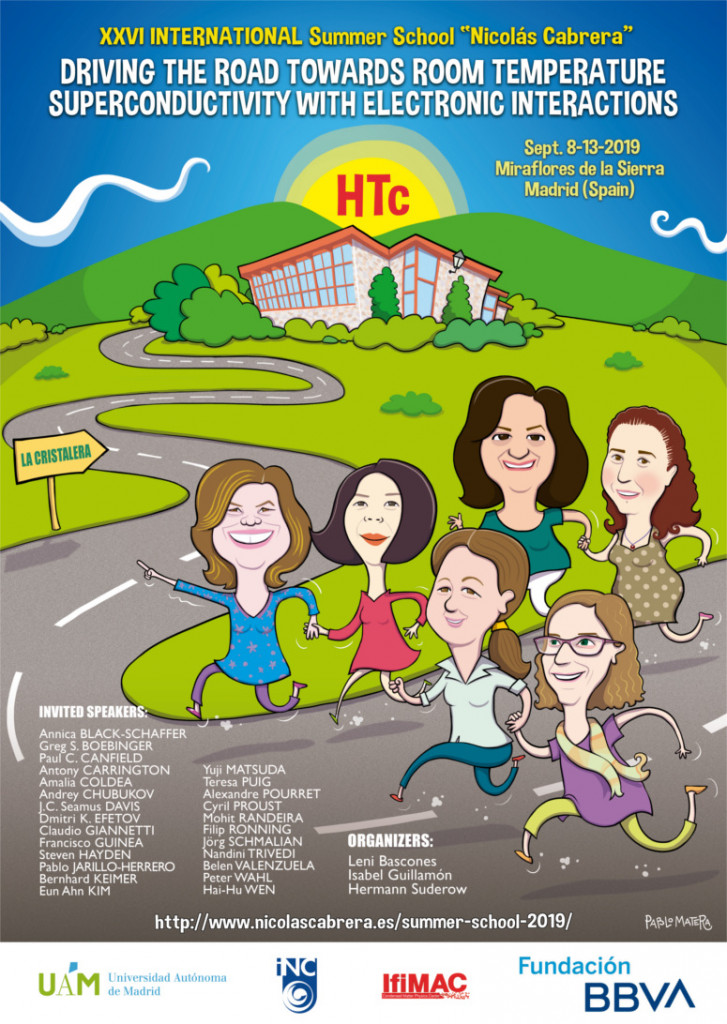Summer School 2019: Driving the road towards room temperature superconductivity with electronic interactions
XXVI International Summer School ‘Nicolás Cabrera’
Driving the road towards room temperature superconductivity with electronic interactions
Miraflores de la Sierra, Madrid, Sept. 8-13, 2019

Program and announcements
- Some of the talks are available as pdf files here:
- Dissemination by FBBVA:
- Press release by FBBVA and video.
- Interviews and comments to Pablo Jarillo-Herrero, here and here.
- The abstract book is available here.
- Short program, available here.
- Download Summer School 2019 Poster – full resolution.
- Details about the way to the meeting are provided in the abstract book.
- There will be a bus departing on 08 September at 18h00 from the bus stop of the T4 terminal at Barajas airport, Madrid. Please search for this logo when you go out of T4 (there is only one exit, see here).
Scope and goals
The challenge to find really high critical temperature (HTc) superconductors was probably first envisioned by a large community of researchers during the late eighties, with the discovery of cuprate superconductivity. After three decades of research, the vision is on the focus again thanks to the discovery of HTc superconductivity in iron-based compounds. HTc superconductivity is found in close proximity to new electronic phases, in particular close to a quantum critical point.
The INC Summer School 2019 is focused on electronic correlations, the vehicle that many want use to drive towards room temperature superconductivity. Charge density waves, antiferromagnetism and, most recently, nematic order, are identified ubiquitously in relation to HTc superconductivity. Electronic correlations driving magnetic order or nematicity and pinning down superconductivity are tightly intertwined. New technologies, such as high magnetic fields, atomic level precision measurements or ultrafast spectroscopies are needed to disentangle the microscopic essence of correlated electron superconductivity from the rich phenomenology of the intertwined phases. The recent discovery of strong electron interactions and superconductivity in graphene strengthen the motivation and suggest that the goal of finding the materials needed to build useful zero resistance appliances might be closer than we thought of.
The objective of the Summer School is to present a fresh overview about the state of the art in HTc superconductivity by gathering main actors in the field. We will provide a bird’s eye view and zoom deep inside the recent advances obtained from experiments and theory. We will discuss new developments in material synthesis, novel experimental probes with high resolution in extreme conditions and powerful theoretical methods. These have been triggered during the last few years to find new clues on electronically driven HTc superconductivity and have made a great impact on other areas in material science.
Speakers
- Annica BLACK-SCHAFFER. Uppsala University, Sweden.
- Greg S. BOEBINGER. National High Magnetic Field Laboratory, USA.
- Andrés CANO. Institut Neel, CNRS &UGA, France.
- Antony CARRINGTON. University of Bristol, UK.
- Amalia COLDEA. University of Oxford, UK.
- Andrey CHUBUKOV. University of Minnesota, USA.
- J.C. Seamus DAVIS. University of Oxford, UK.
- Dmitri K. EFETOV. Institute of Photonic Sciences, Barcelona, Spain.
- Claudio GIANNETTI. Univesitá Cattolica del Sacro Cuore, Brescia, Italy.
- Przemyslaw GRZYBOWSKI. ICFO and Adam Mickiewicz University, Poznań, Poland
- Francisco GUINEA. IMDEA Nanociencia, Madrid, Spain.
- Stephen HAYDEN, University of Bristol, UK
- Pablo JARILLO-HERRERO. Massachusetts Institute of Technology, USA.
- Bernhard KEIMER. Max Plank Institute for Solid State Research, Stuttgart, Germany.
- Eun-Ahn KIM. Cornell University, USA.
- Yuji MATSUDA. Kyoto University, Japan.
- Alexandre POURRET, Université Grenoble, France
- Cyril PROUST, Laboratory of Intense Magnetic Fields-Toulouse, France
- Teresa PUIG. Institute of Materials Science of Barcelona, Spain.
- Mohit RANDERIA, The Ohio State University, USA
- Filip RONNING. Los Alamos National Lab, USA.
- Jörg SCHMALIAN. Karlsruhe Institute of Technology, Germany.
- Nandini TRIVEDI, The Ohio State University, USA.
- Belen VALENZUELA. Instituto de Ciencia de Materiales de Madrid, Spain.
- Peter WAHL. University of Saint Andrews, UK.
- Hai-Hu WEN. Nanjing University, China.
History and venue
The International Summer School “Nicolás Cabrera”, funded by the BBVA Foundation, deals with current topics in materials science, condensed matter physics, nanophysics and biophysics since 1994. The School is a meeting point for numerous scientists all over the world, who share a few days in Madrid in a particularly pleasant and interacting environment.
The School is organized in the residence “La Cristalera” in Miraflores de la Sierra, a small village in the mountains near Madrid. There will be a welcome reception on Sunday, Sep 8, with lectures taking place from the morning of Monday, Sep 9, until lunch on Friday, Sep 13. Bus transport from Madrid airport and back will be provided on Sunday, Sep 8, and Friday, Sep 13, respectively.
Dates
12th of June 2019. Application for School and for scholarships.
September 8th-13th, 2019. Arrival will be on sunday 8th during the afternoon. Excursion and conference dinner will be to Segovia.
Registration
Registration is closed.
Organizers
- Elena Bascones, ICMM-CSIC
- Isabel Guillamón, IFIMAC-UAM
- Hermann Suderow, IFIMAC-UAM
Contact
e-mail: school.nicolascabrera@uam.es.
